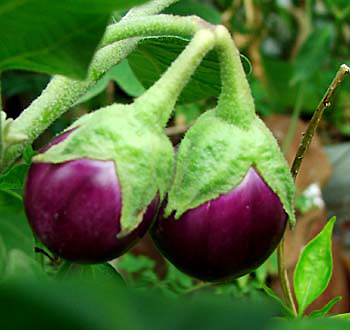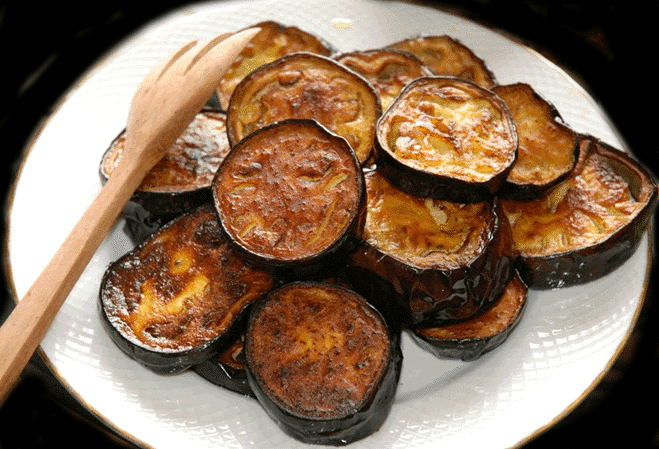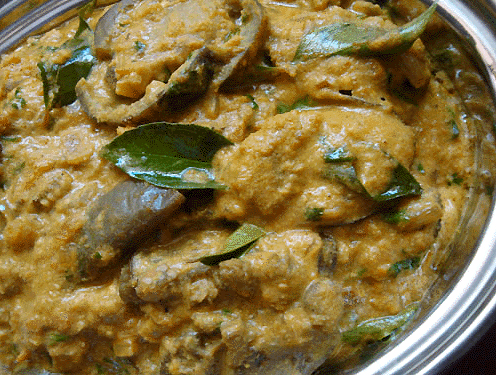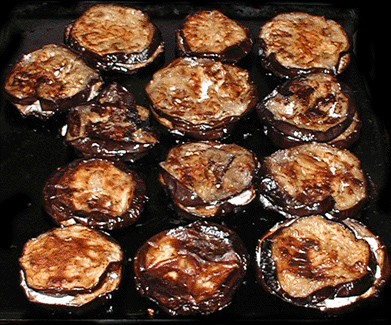
|
|
|
|
BY: SUN STAFF
 Jul 01, 2010 — CANADA (SUN) — A journey through India: border to border, bhoga to prasadam. Just as we seldom think of brinjal as an ingredient in sweets, we rarely think of it as a breakfast food. But as we hear from Srila Prabhupada during a conversation in Tehran (Aug 9, 1976):
"And mix with mustard oil and this, what is called, eggplant. Eggplant roasted in the fire and put with little mustard oil, salt and chilis, it becomes very tasteful. So puffed rice and that, they take in Bengal. That is tiffin, for breakfast. Formerly they were happy simply by eating palatable dishes..." The enjoyment of a dish comes not only from its flavor, but also from the aroma and visual presentation. The aroma of brinjal is generally ruled by the dominant spice or other vegetables in the dish. Color and appearance of the cooked preparation can range from brown to green, purple, or reddish, depending on the sauce. Many preparations call for lightly frying the brinjal pieces, and all brinjal tends to turn brownish as soon as its peeled, what to speak of fried. In dishes such as raitas or salads, however, it's nice to preserve the whitish color of the flesh. To prevent discoloration, use a stainless steel knife to cut, and sprinkle the pieces with salt or lemon juice immediately after cutting, or submerse in water. There are many ancient varieties of brinjal white, purple, and green, shaped like small eggs, long and thin, or large and bulbuous. At least 50 varieties of brinjal are commonly available in India, and each has a unique feature. Most are used for culinary preparations. Some varieties have great medicinal value, like Sunde kai, which is used to relieve joint pain, and Ramagulle badane, a wild variety that helps prevent tooth decay. Others, like the Mattu gulla from Udupi district, are famous for their distinctive flavour. Unfortunately, today these heirloom varieties are at risk of being joined by genetically modified varieties that big agro and the government of India are threatening to release into the food chain. BT Brinjal (Bacillus thuringiensis) will be the first to get approval, if the wellspring of resistance that has grown against it should fail.

Even the ancient variety of brinjal we focused on yesterday, Mattu gulla, is now an endangered variety, thanks to BT Brinjal. The Mattu gulla variety has been tampered with by the Frankenfood scientists at the University of Agricultural Sciences in Dharwad. They've introduced the BT gene into Mattu gulla and conducted field trials, which means the local seed stock is now at risk. We encourage devotees everywhere to take an active role in helping to protect Mother India's ancient seeds stocks, and where better to start than with brinjal. With a little research, seeds can be found for most varieties, and they'll adapt and grow in most reasonable climates. In more tropical zones, many varieties will grown year round, or at least nine months. Elsewhere brinjal will grown most anywhere you can grow tomatoes. Save the seeds and pass them on, encouraging your own temple community to raise these excellent heirlooms for Sri Krsna's pleasure. Among the varieties most notable for their excellent flavor are the Billi gulla badane, another Udupi native that has excellent taste and grows well, even on barren land. This brinjal is said to 'melt like butter in the mouth'. Also recommended is Mangalooru badane, often used in sambhar and chutney, and Kothithale badane, a very soft, flavorful native of the Bangalore area. Nearly any variety of brinjal can be used in the following recipe for Brinjal Gravy, with great success.

Stuffed Brinjal

Fried Brinjal Because brinjal originated in India in ages past, many references are found in ancient writings to the various preparations that have been enjoyed over hundreds, if not thousands of years. One of the oldest is the Manasollasa written by King Someshwara of Kalyana, Central India, around 1130 A.D. He refers to a non-vegetarian preparation to which brinjal pieces are added. In 1485 A.D., Terakanambi Bommarasa described a preparation called Brinjal Bhartha, which was served at royal feasts. It was made with shredded coconut, curry leaves and cardamom, mixed well and flavored with citrus juice and a little camphor. The Lingapurana of Gurulinga Desika, written in 1594 A.D., offers a description of several brinjal preparations. One calls for seasoning the brinjal with ghee, salt, methi (fenugreek), black gram (urad dahl), and cream, then boiling it. Another calls for roasting the brinjal in ghee. One refers to placing the brinjal on red-hot coals to make Bhartha. Another describes a sweet dish made by cutting the brinjal into small pieces and cooking with jaggery, etc. In the Shivatattvaratnakara written by King Basavaraja of Keladi (Karnataka) around 1700 A.D., he describes brinjal that is fried with rice grits. Shankaradeva's Shreeramabhagavata refers to the popularity of a brinjal preparation made in medieval Orissa and Bengal, composed of boiled rice covered with water and left overnight, eaten the next morning with brinjal curry as an accompaniment. In his Ain-i-Akbari, Mughal court historian Abu'l Fazl gave a detailed account of the fruits and vegetables grown in India during the reign of Akbar. The badinjan (brinjal) is one of the 18 vegetables said to be available throughout the year. Many ancient documents refer to the healthful and medicinal qualities of brinjal. It is an important vegetable for those dealing with Type-2 diabetes, known to reduce hyperglycemia. Modern medical establishments call for a brinjal-based diet because of its high fiber and low soluble carbohydrate content. Another popular home remedy is to cut fresh brinjal into cubes and soak them, completely covered, in apple cider vinegar for three days, in a glass container. A cotton swab is then dipped into the vinegar, and swabbed on problem skin areas. This tincture is said to greatly reduce the size of tumors and moles that have become enflamed. It is also a good general remedy for cleansing the skin.

Brinjal Curry Brinjal in many forms goes very well with breads. Binjal curries and gravies are excellent served with chapatti or naan for dipping. Eggplant diced into small bits and sprinkled with turmeric and salt, coriander or asofoetida then fried in ghee, is an excellent addition to fried or baked breads. The crispy bits can be folded into the dough, or layered and rolled into parathas. You can also make a mash of spiced, roasted brinjal and pour it as a middle layer in idlis. Here's an excellent Brinjal Curry to offer with hot breads: Ingredients: Wash and cut the Brinjals into round slices. Fry in a little ghee until they're tender. Meanwhile, lightly roast the peanuts, sesame seeds and dry red chillies, then grind them into a paste along with the coconut, adding scant water. In another pan, cook the tomatoes in a little ghee until softened, then and the paste and fry for a minute or two. Add the remaining spices, green chillies and curry leaves, and sauté for a few minutes. Finally, add the water, tamarind juice and salt and boil to thicken the gravy. Add the fried brinjal and cook, covered, over low heat for 15 minutes. Garnish with fresh coriander leaves and offer with chapattis, pooris or paratha.

Eggplant Brahmastra Finally, here is a brinjal recipe from our own Raghava's Bag cookbook, for Eggplant Brahmastra. Created as an offering for Lord Nrsimhadeva, the Brahmastras are golden slices of roast brinjal that are stuffed with a creamy, spicy mixture. Srila Prabhupada describes the brahmastra as being similar to a modern nuclear weapon that acts on combustibility and creates an intolerable heat. This recipe controls the heat factor in an interesting way: by folding all the hot spices (chilis, black pepper and fresh ginger) into cream cheese, which soothes the tongue. Each bite is a combination of heat and cool. Use full-sized purple eggplant that are fat and round rather than long and narrow, so that your Brahmastra discs will be large and uniform. When adding chilis, pepper and ginger to the cream cheese, err on the side of excess. As a general rule of thumb, add three times the amount of chilis you think you should, because the cream cheese moderates the heat so nicely. Ingredients: Wash and dry the eggplants, then cut the stem cap off each one. Without peeling, slice the whole eggplant into rounds about one-half inch thick. Place in a large bowl and gently toss with ghee or olive oil, or brush oil onto each piece, both sides. You'll want just enough oil to darken the fruit, but don't overdo it. Lay the oiled eggplant on a baking sheet and bake at 425 degrees F for about half an hour, flipping them once midway through. When both sides are dark golden and crispy, take them out and place on a cooling rack. Meanwhile, mix together the cream cheese stuffing and let it sit at room temperature. When the eggplant discs are cool enough to work with, match up two pieces of like size and stuff them with a thick dollop of the cream cheese mixture. Make the 'sandwich' neat, so the cream cheese isn't spilling over the edges too much. Each Brahmastra should have 2 to 3 tablespoons of filling. Once filled, you can offer immediately, or cover and refrigerate until needed. If refrigerated, place them back on a baking sheet and heat at 350 degrees F for 5 to 8 minutes before serving, so they're nice and warm when offered.
| |